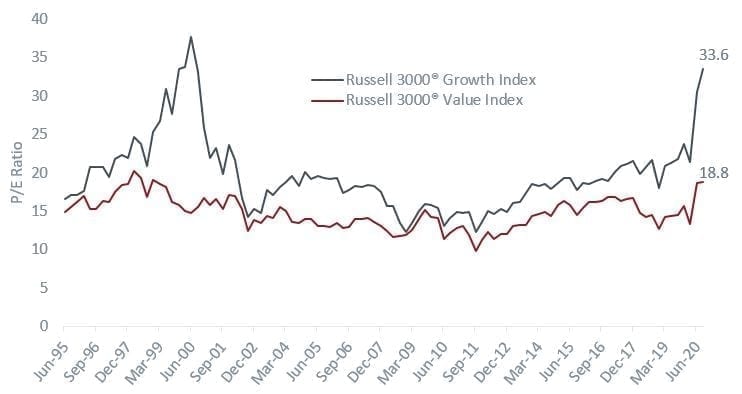Subscribe
Sign up for timely perspectives delivered to your inbox.
Perkins US equity Portfolio Manager Ted Thome discusses opportunities created by the current market and why now may be a good time for investors to position their portfolios for a changing environment.
Fall (Autumn) is approaching for those of us in the northern hemisphere, and with it will come the season when farmers reap and protect the rewards of seeds sown over the past several months. So, too, may be the case for investors as they look to reap the rewards of what has been a bumper crop for equities. The US stock market recently surpassed its all-time high despite an extremely challenging economic backdrop. Now may be a good time to harvest some of those gains and prepare for the next season.
This may be especially true for growth equities, which have significantly outperformed value equities for the better part of the last 13 years. In 2020 alone, the Russell 3000® Growth Index has outperformed the Russell 3000® Value Index by a stunning 40.3% (through to 1 September 20201). However, while the current outperformance has been particularly persistent, value and growth investing tend to be cyclical, alternating leadership over extended periods of time. Moreover, the valuation spread between growth and value has expanded to near all-time highs, approaching levels last seen during the late ’90s tech bubble, as seen in the chart below. While this trend could certainly continue, history indicates that valuation spreads typically compress. For these reasons, it may make sense for some investors to consider a move toward value and away from growth.

Source: Bloomberg. BEst P/E Ratio, blended 12 months, 30/06/95 – 02/09/20, quarterly data.
Past performance is not a guide to future performance.
Similarly, in the bond market, the Bloomberg Barclays US Aggregate Bond Index, which is largely composed of US Treasury (UST) and investment-grade bonds and Agency Mortgage Backed Securities (MBS), has outperformed some of the lower-quality, higher-yielding areas of the market this year2. The US Federal Reserve’s (Fed) open market purchases of high yield securities and its willingness to let inflation run higher than the 2% target create a potential opportunity to capture more income and relatively attractive returns in higher-yield fixed income versus the lower-yielding sectors of the bond market, due to the Aggregate Index’s longer duration and the rally in UST securities.
Just as each new season brings change, the natural progression toward retirement gives rise to evolving needs and goals. It is about this time that those approaching retirement consider positioning portfolios more towards a long-term harvesting phase by increasing allocation to income-producing investments. However, with the current ultra-low interest rate environment, finding attractive yields is not necessarily an easy task.
Since global central banks are expected to keep policy rates at or near zero for the foreseeable future, some investors may be looking to rotate a portion of their portfolio into defensive value dividend equities and differentiated multi-sector fixed income. With high-quality value equities, investors have the potential to collect relatively attractive dividends while they wait for a possible rotation to value from growth, accepting some risk to capital in exchange for the possibility for higher income and potential capital appreciation.
In our view, defensive value equities combined with lower-risk high-yielding fixed income may be a prudent strategy for investors seeking to store gains, generate income and potentially be better protected from some of the harsher weather that could arise in the markets.
1Source: Refinitv Datastream, Russell 3000 Growth Index, Russell 3000 Value Index, 31 December 2019 to 1 September 2020. 13 years relates to period from 31 December 2006, total return in USD.
2Source: Bloomberg Barclays US Aggregate Index, Bloomberg Barclays US Corporate High Yield Index, total return in USD, 31 December 2019 to 1 September 2020.